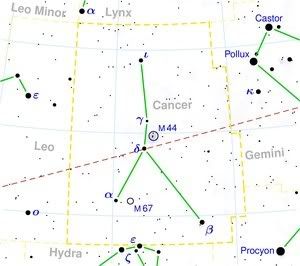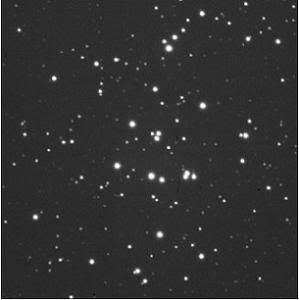|
|
Post by glactus on Feb 17, 2008 10:30:02 GMT
 The sun passes this constellation from late July to early August. In former times the Sun used to lie in this constellation when it reaches the zenith, its point farthest north - the time of the summer solstice. Nowadays the sun lies in the neighbouring constellation Gemini on the time of the summer solstice (due to the effect of precession). Although cancer belongs to the Zodiacal Family it is associated with the Hercules constellation family. Stars and other objects: An attractive yet unusal triple for small telescopes is zeta Cnc. Two of the stars form a binary, consisting of two yellow stars of 5th mag and 6th mag. These two revolve each other with a peroid of 60.1 years. Also good viewable with small telescopes is iota Cnc, a 4th mag yellow giant with a 7th mag green companion.  M 44 This famous cluster, M44, is also called Praesepe (Latin for "manger"), or the Beehive cluster. It is also one of the objects easily visible to the naked eye, and thus known since prehistoric times. M44 is .577 light years from Eareth and is of magnitude 3.7.  M 67 The second Messier object in this constellation, M67 requires larger telescopes. It is by far the oldest of Messier's open clusters, being aged at 3.2 billion years, is of magnitude 6.1 and about 2.7 light years from Earth   credits: images: images.google.com.au/images?client=firefox-a&channel=s&rls=org.mozilla%3Aen-US%3Aofficial&hl=en&q=M67&btnG=Search+Images&gbv=2Text by Wikipedia |
|